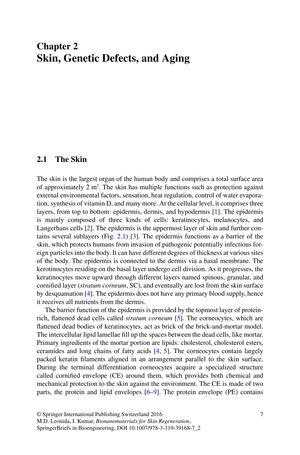TLDR Genetic defects and UV radiation cause skin damage and aging.
The document detailed the structure and function of the skin, focusing on genetic defects like lamellar ichthyosis, Vohwinkel syndrome, and epidermolysis bullosa simplex, which result from mutations in structural proteins and lead to conditions such as hyperkeratosis and blistering. It also covered skin aging, distinguishing between intrinsic (genetic) and extrinsic (environmental) factors, with a significant emphasis on photoaging from UV radiation. UVA and UVB radiation caused skin damage through different mechanisms, including the production of reactive oxygen species (ROS), which contributed to oxidative damage and extracellular matrix (ECM) degradation. The degradation of structural proteins like collagens and elastins by matrix metalloproteinases (MMPs) and elastases led to thinner skin and reduced elasticity, with chronic UVB exposure also causing the loss of hyaluronic acid in the dermis.
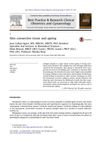 77 citations
,
July 2013 in “Best Practice & Research in Clinical Obstetrics & Gynaecology”
77 citations
,
July 2013 in “Best Practice & Research in Clinical Obstetrics & Gynaecology” Menopause reduces skin collagen and elasticity, and while estrogen therapy can help, its risks require careful consideration.
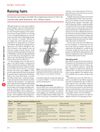 8 citations
,
June 2011 in “Nature Biotechnology”
8 citations
,
June 2011 in “Nature Biotechnology” Stem cell treatments can potentially treat baldness, with one trial showing hair growth after injecting a hair-stimulating complex, and no safety issues were reported.
1279 citations
,
November 2005 in “Nature Medicine” 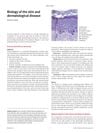 7 citations
,
December 2004 in “Medicine”
7 citations
,
December 2004 in “Medicine” Knowing how skin works and its diseases helps doctors diagnose and treat skin conditions better.
158 citations
,
May 2003 in “Journal of Investigative Dermatology” Hair growth is influenced by dynamic changes in hair follicle cells, which could help treat hair loss.
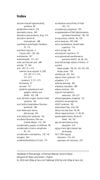
The document is a detailed guide on skin conditions and treatments for dermatologists.
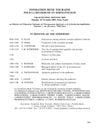 3 citations
,
September 2005 in “Experimental dermatology”
3 citations
,
September 2005 in “Experimental dermatology” The cornified envelope is crucial for skin's barrier function and involves key proteins and genetic factors.
 November 2019 in “Harper's Textbook of Pediatric Dermatology”
November 2019 in “Harper's Textbook of Pediatric Dermatology” The document is a detailed medical reference on skin and genetic disorders.
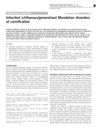 81 citations
,
June 2012 in “European journal of human genetics”
81 citations
,
June 2012 in “European journal of human genetics” Inherited ichthyoses cause widespread skin scaling and thickening due to gene mutations.
 6 citations
,
September 2012 in “Our Dermatology Online”
6 citations
,
September 2012 in “Our Dermatology Online” Retinoids are effective for various skin conditions and hair loss but have serious side effects, so low doses are recommended.
